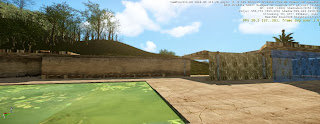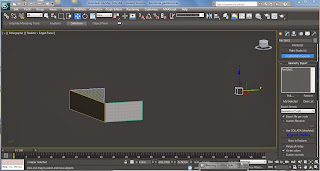Event
The island was once a beautiful place with tourists, until one day, the peace was disturbed and the island was overtaken by intruders and they inhibited the island before human life on earth ended.
Architecture
The materials used in the building were mostly strong materials. However, due to abandonment after human left, the building is left unmaintained. The marble loses polish and shine as well as discolouration. It slowly cracks and detach. To create that effect, faded coloured material and rayfire were used. Concrete materials cracked and detached, dirty and has vegetations growing and sipping into the cracks. The roofs, exposed to the environment became mossy and cracked, the roofs falling apart and breaks. As for the glass, it became dirty and cloudy, having cracks on them. The metal columns rust overtime. As for the surroundings, there were branches, fallen trees, rubbish left that is slowing feeding the vegetation causing overgrowth everywhere.
Interactivity
The video shows the past of how the place was attacked by intruders and whats left behind after they died. The roofs breaks and falls apart, concrete walls cracked, and floor tiles cracked with vegetation growing and filling up the cracks.
Environment
The island 100 years after human life is imagined to be dark, dull and gloomy. The abandoned building surroundings has overgrowth everywhere, almost swallowing the building into the forest. The environment has vegetation, dead branches, dried leaves, and tall grass. It also shows destruction and damage and rubbish left by the intruders 100 years ago.
5 X images of draft and final CryEngine3 environment
ONE- Abandoned and destroyed
 |
| Before and After Destruction |
TWO- Interior
 |
| Interior |
THREE- rooftop
 |
| Roof top |
FOUR- the environment after intruders took over and whats left 100 years after they died
 |
| the environment |
FIVE- The building
 |
| The building and its surroundings. Overgrowth |
Trailer
https://www.youtube.com/watch?v=cpTZWxHcNqg&feature=c4-overview&list=UUvr9Rav3Yz-_oh-TarQ0cBA
3DS Max File
http://www.gamefront.com/files/23857480/barcelona_pavillion.zip
Crysis play test files
Level Folder. Modified level of exp1 for exp2(life after people)
http://www.gamefront.com/files/23857574/g5_EXP1.zip
Objects Folder
http://www.mediafire.com/download/vdyg4pwb1bvjnan/Objects(2).zip
Weekly Progress
Weekly Tasks (Experiment 2)
Week 1: Task and Independent study
Week 2: Task and Independent study
Week 3: Task and Independent study
Week 4: Task and Independent study
Week 5: Task and Independent study
Weekly Tasks (Experiment 1)
Week 1: tasks
Week 2: tasks
Week 3: In-class and independent study
Week 4 The Sublime: In-class and independent study
Week 5 The Subliminal: In-class and independent study
Week 6: In-class and independent study
Week 7: Reflection and submission week
















































